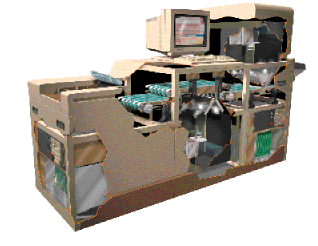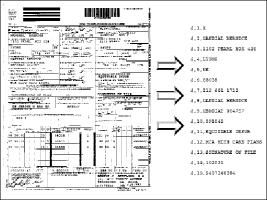ElectroCom Imaging
By Paz Kahana, Marketing Director
ElectroCom Imaging
ElectroCom Imaging (ECI) comes from a family of companies that has been quietly providing advanced imaging solutions to postal automation problems for over 15 years.
Headquartered in Arlington, TX, ElectroCom Imaging was formed in 1995 as a division of ElectroCom Automation. Jeff Gilb, ECI's general manager and ElectroCom vice president, summarizes ECI's charter: "Our mission is to provide advanced, user-friendly products offering superior price performance for use in complex imaging applications."
Having its roots in the combined resources of ElectroCom Automation and AEG ElectroCom of Konstanz, Germany--both major providers of imaging-based postal automation systems--ECI is now offering products and services for commercial markets. At this time ECI offers two major product lines: AEG Recognition, a world-renowned family of integrated ICR/OCR engines, and the IntelliScan 120/240 family of high-performance document scanners.
The AEG Recognition offers commercially the underlying technology that automatically reads the myriad pieces of US mail at very high speed. The advanced ICR/OCR technology that has been used to sort the U.S. mail for 15 years is now available to integrators and developers of commercial imaging applications.
ECI has applied its accumulated know-how in paper feeding, transport and advanced image processing technologies to develop the IntelliScan 120/240, which was previewed at AIIM 95.
Production Scanning--Problems and Solutions
High-volume production scanning presents a complex set of technical and operational needs and challenges. Ranging from the need to scan extremely large volumes of paper, allow for a variety of paper types (size, weight, orientation) manage the prep and batching process, and ultimately extract useful information from the paper, these needs make high-end scanning a challenge.

ECI gained its imaging
experience by working with postal systems around
the world.
Consider the path of a typical piece of mail as it is scanned, recognized and sorted on ECA systems. As all mail must be oriented properly for reading, the first step is to sort it from the random mix created by large source bins. Every mail piece is first sorted into one of eight bins based on intelligent page decomposition analysis. Special algorithms developed by ECA are used to search for expected page components such as stamp, address, return address, etc.
Once sorted, the mail is fed to reading machines that determine address readability. If the mail is readable, the machines apply ICR/OCR to it. Addresses are then verified and cross-compared to the postal database, and, if they are correct, the special postal bar code is sprayed on the letter. This bar code is then read by other sorting machines as further processing and sorting is performed.
The last step is to feed the mail to configurable sorting machines that read the postal bar code and sort the mail down to a level of city, ZIP Code, or even mail carrier route, depending in most cases on the destination area and the sorting location. The entire automated sorting process is performed at the high speed of 10 letters per second.
The technology that ECA has successfully applied in order to achieve this high level of postal automation is based on two main areas: fast and reliable paper feeding, handling and transport; and advanced, accurate image processing and recognition. A great deal of sophistication is required to read a hand-written address in red from a green envelope, or pink hand-printed letters on a purple background.
This technology has allowed the vast majority of the 88 billion pieces per year of US mail to be handled by ECA imaging equipment. With well over 500 large sorting machines, and annual volume of billions of pieces of paper, it could be said that ElectroCom Automation supports the largest imaging-based application in the US.
The IntelliScan 120/240: The Scanner that Does More
As applications and users continue to demand more powerful functionality and greater simplicity of operation, the ability to perform more in the scanner becomes a product requirement. ECA has incorporated enormous power into the IntelliScan, making it now possible to scan and process 120 pages per minute (240 pages per minute in duplex) at a resolution of 300 DPI in true grayscale.
Images Created in 8-bit Grayscale
From its inception, ECI's goal for InrtelliScan was to offer the best image quality possible. Images are created in 8-bit grayscale and are processed in grayscale for skew, background noise and contrast by the scanner to produce the ultimate image quality. Images are also rotated if necessary.
To minimize paper misfeeds and jams, ECI designed an advanced, straight paper path, aided by belts, guides and vacuum to hold the paper securely in place, and swiftly transport it through the scanner. Paper is fed from the bottom of the pile by the advanced automated feeders ECI designed for the IntelliScan. Feeders are available in a choice of manual, 300- and 1,500-page capacity. Paper is smoothly deposited at the output tray without reversing the order.
Unique to the IntelliScan architecture is a fast, onboard 300 MHz Alpha processor running the Windows NT operating system. With it, ECI was able to integrate powerful and useful functions right into the scanning operation.
The IntelliScan offers an easy way to auto-index images as they are scanned. Using AEG Recogniton, users can apply ICR/OCR, as well as barcode and patch code to the images to extract field contents that can be used for indexingThat information is output along with the image.
IntelliScan also offers an output paper-sorting capability based on either a fixed set-up (such as paper size) or on field content. As an example, this capability may be used to separate checks or detect forms that are missing required information in one or more fields.
With these advanced capabilities, the IntelliScan 120/240 changes the way high-volume scanning applications can operate.
With the generous benefits offered by these advanced features and capabilities, the IntelliScan 120/240 makes heads turn. It changes the way high-volume scanning applications can operate.
Never before has high-speed scanning been automated to the point that the scanning device not only creates the images, but also processes them. In the past, most processing of images had to be done in either controller cards or dedicated servers and processing stations, at added system complexity and cost.
Taking advantage of the powerful connectivity or Windows NT, the IntelliScan is the only production scanner that interfaces directly to the network. It can easily be connected to standard networks using any of the supported NT protocols.
In fact, with the IntelliScan, ECI has defined a new scanning paradigm we call IntelliScanning--perform more tasks in the scanner, and simplify the overall application architecture.

A typical application for the AEG Recognition is the HFCA form
Early customers are realizing the benefits of IntelliScan. CTB/McGraw-Hill (Monterey, CA), the nation's largest commercial test publisher in the K-12 education market, has seen an increase in test scoring productivity, speed and flexibility. Document Management Systems (Lufkin, TX) was able to perform a demanding, large-volume medical recordes backfile donversion job speedily and at reduced overhead costs. ScanCenters of America (Natick, MA), a fast-growing national service bureau chain, is looking to increase production capacityand and has bid on larger jobs more competitively.
AEG Recognition: Highly Used and Proven ICR/OCR
As part of the strategy of providing the best products for high-volume scanning and imaging, ECI is also marketing the AEG Recognition family of hardware and software products in the US. The AEG Recognition family offers the same technology and algorithms in the high-speed PLE 610H hardware engine, and in software for OS/2, Solaris and Windows NT as the PSW-6120.
AEG is a leader in ICR accuracy. Motivated by its fast growing European giro business (a form that most Europeans use to authorize their banks to pay monthly utilities and other bills), AEG developed sophisticated ICR technology. As a result, the nearly 220 hand- and machine-printed font classifiers (offered for many languages) have been carefully optimized for the most difficult conditions. These conditions include overlapping, broken or touching letters, excessive noise and other image obstruction.
The AEG ICR/OCR engine works well in real-life, under a wide range of paper and text conditions. Installed in thousands of sites throughout the world, it is the same engine that forwards your mail to you. The AEG Recognition is used by postal services in many leading western countries, including the United States, The United Kingdom and Germany. With the AEG Recognition, you know you are using the postal service-tested, field-approved engine.
Redefining High-volume imaging
Redefining high-volume imaging production can be done with only the most advanced technologies and an innovative approach.. ElectroCom Imaging has made the first steps in this direction with the IntelliScan and AEG Recognition.
The AEG Recognition was the first product to integrate ICR and OCR into one operation performed by one engine. It broke the old recognition paradigm of separting ICR from OCR. The IntelliScan has broken yet another old paradigm by bringing into the scanner a variety of what have been classically post-scanning tasks. You integrate less, and get more.
So it's no longer a secret. Now you know. Backed by production imaging experience and proven, advanced technologies, ECI now delivers commercially.
Paz Kahana is northeast sales representative for ElectroCom Imaging (Fairfax, VA). He can be reached at 617-965-1014.
IW Special Supplement, March 1996
|

![]()
![]()
